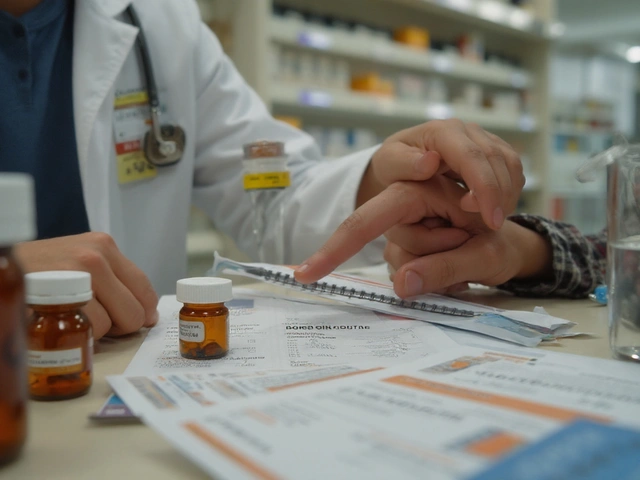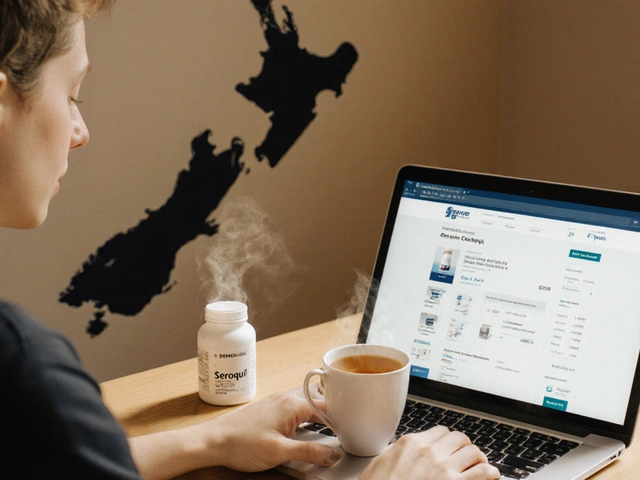If you typed “Levothroid” into search, you probably want straight answers: what it is, whether it’s still sold, what to use instead, and how to take it safely without your thyroid going haywire. You’ll get that here-in plain English, with practical steps you can actually follow. I live in Wellington, so I’ll also point out what’s different in New Zealand. Expect advice you can use today, backed by clinical guidelines and our local formulary.
- Levothroid is a brand name for levothyroxine (synthetic T4). The Levothroid brand was discontinued years ago; pharmacies will supply levothyroxine instead.
- Replacement dosing is usually weight-based; start low and go slow if you’re older or have heart disease. Recheck TSH 6-8 weeks after any dose or brand change.
- Take it on an empty stomach at the same time each day. Keep calcium, iron, and coffee away from it by several hours; they block absorption.
- Side effects usually mean your dose is off. Serious symptoms (chest pain, severe palpitations) need urgent care.
- In New Zealand, Eltroxin (levothyroxine) is standard. If switching brands or forms, redo labs and watch symptoms closely.
What Levothroid Is and Why It’s Hard to Find in 2025
Levothroid was a branded tablet form of levothyroxine-synthetic thyroxine, the same hormone your thyroid gland makes. Doctors use levothyroxine to treat underactive thyroid (primary hypothyroidism), post-thyroidectomy replacement, and to suppress thyroid-stimulating hormone (TSH) after thyroid cancer.
Availability in 2025: the Levothroid brand was discontinued for business reasons about a decade ago. That doesn’t affect the medicine itself; it just means you’ll get levothyroxine under other brand names or as a generic. In the US you’ll see Synthroid or Levoxyl. In New Zealand, pharmacies commonly dispense Eltroxin (levothyroxine sodium). The active ingredient is the same across brands, but small differences in tablet formulation can change how much you absorb.
Why brand matters a bit: thyroid hormone has a narrow therapeutic window. Even small changes in absorption can nudge your TSH up or down. That’s why guidelines recommend checking labs 6-8 weeks after any dose change or brand switch. If you’re stable on one brand, staying consistent helps keep symptoms away.
Trusted guidance: The New Zealand Formulary (2025) and the American Thyroid Association both recommend consistent product use and timed TSH checks after changes. Medsafe data sheets reinforce empty-stomach dosing and the need to separate levothyroxine from mineral supplements that bind the drug in your gut.
Quick actions if your script still says “Levothroid”:
- Ask the pharmacy to fill it with levothyroxine tablets at the same microgram dose.
- If you’re sensitive to brand switches, ask your prescriber to note a preferred brand and plan a TSH check 6-8 weeks after the switch.
- Keep the old pill bottle or a photo of the tablet for reference until you’re stable on the new product.

How to Use Levothyroxine Safely: Dosing, Timing, Interactions, Monitoring
Getting thyroid replacement right is about three things: the right dose, consistent timing, and smart lab follow-up. Here’s how to do it with the least drama.
Dosing basics (adults):
- Typical full replacement: about 1.6 micrograms per kilogram of body weight per day (use ideal/lean weight if you carry extra body weight). Example: a 70 kg adult often lands near 100-125 mcg daily.
- Start low, go slow if you’re over 60 or have heart disease: begin 12.5-25 mcg daily and increase by 12.5-25 mcg every 6-8 weeks based on TSH and symptoms.
- Subclinical hypothyroidism (mild, TSH a little high): many people need less than full replacement-often 25-75 mcg daily, titrated to goal.
Pediatric dosing is weight-based and age-specific. For congenital hypothyroidism, early adequate dosing is crucial for brain development-this is managed with a pediatric endocrinologist.
How and when to take it (so you actually absorb it):
- Empty stomach is non-negotiable. Take it first thing in the morning with water, then wait 30-60 minutes before food or coffee. Or take it at bedtime, at least 3 hours after your last meal-pick one method and stick with it.
- Minerals block absorption. Separate levothyroxine by at least 4 hours from calcium, iron, magnesium, zinc, and multivitamins.
- Coffee and fiber can interfere. Give coffee 60 minutes of space. High-fiber meals are fine-just not at the same time as your dose.
- Stomach medicines can lower absorption. Proton pump inhibitors, bile acid binders (cholestyramine), sucralfate, and orlistat can all get in the way. Your prescriber may adjust timing or dose if you need these.
- Consistency beats perfection. If your morning routine is chaotic, nighttime dosing can be easier-as long as you keep it 3+ hours after dinner.
What to do if you miss a dose:
- If you remember the same day, take it when you remember, away from food and interfering meds.
- If it’s nearly time for your next dose, skip the missed one. Don’t double up unless your clinician told you to. Levothyroxine has a long half-life, so a single missed dose is rarely a big deal.
Side effects and what they usually mean:
- “Too much” symptoms: racing heart, anxiety, tremor, heat intolerance, sweating, insomnia, unintentional weight loss, diarrhea. Call your prescriber; you likely need a dose decrease.
- “Too little” symptoms: fatigue, cold intolerance, weight gain, dry skin, constipation, low mood, brain fog. You may need a dose increase-after labs confirm it.
- Serious red flags: chest pain, severe palpitations, shortness of breath, confusion, or sudden weakness-seek urgent medical care.
Monitoring schedule that actually works:
- New start or dose change: check TSH (and usually free T4) at 6-8 weeks.
- Stable dose: check every 6-12 months, or sooner if symptoms return, you start a new interacting medication, or you switch brands/forms.
- Pregnancy: check about every 4 weeks in the first half of pregnancy, and at least once in the second half. Most people need a dose increase early in pregnancy.
Typical targets for TSH vary by situation. Use this as a quick reference, then tailor with your clinician.
| Situation | Usual TSH Target | When to Recheck After Change | Notes |
|---|---|---|---|
| Primary hypothyroidism (non-pregnant adult) | About 0.5-2.5 mIU/L | 6-8 weeks | Some feel best near 1-2 mIU/L; avoid oversuppression. |
| Older adults or cardiac disease | Often 1-3 mIU/L | 6-8 weeks | Higher target reduces risk of arrhythmia and bone loss. |
| Pregnancy (1st trimester) | About 0.1-2.5 mIU/L | ~4 weeks | Increase dose by ~20-30% as soon as pregnancy confirmed. |
| Pregnancy (2nd trimester) | About 0.2-3.0 mIU/L | ~4-6 weeks | TSH goals shift slightly by trimester. |
| Pregnancy (3rd trimester) | About 0.3-3.0 mIU/L | ~4-6 weeks | Adjust as needed; postpartum needs drop again. |
| Thyroid cancer (TSH suppression) | 0.1-0.5 mIU/L (varies with risk) | 6-8 weeks | Targets set by your oncology/endocrine team. |
Evidence and sources: The dosing and monitoring ranges above reflect the New Zealand Formulary (2025) and the American Thyroid Association’s clinical guidance (originally 2014 with updates referenced in recent reviews). Medsafe data sheets for levothyroxine products support the timing, separation from minerals, and lab monitoring advice.
Drug interactions to know about (not exhaustive):
- Reduced absorption: calcium, iron, magnesium, aluminum antacids, zinc, cholestyramine/colestipol, sevelamer, sucralfate, orlistat, high-fiber supplements, espresso/coffee taken too close.
- Changed requirements: estrogen therapy, pregnancy (increase need); androgens, glucocorticoids (can alter binding proteins). Certain anti-seizure meds (carbamazepine, phenytoin), rifampicin, and sertraline may increase clearance.
- Warfarin: levothyroxine can increase warfarin effect by raising metabolism; if you’re on warfarin, INR monitoring may need adjustment after thyroid dose changes.
Storage matters more than people think: keep tablets dry, at room temperature, away from heat and light. Don’t store in the bathroom. If tablets change color or crumble, ask for a fresh bottle.

Switching from Levothroid: Alternatives, NZ Brands, Special Situations
Since Levothroid isn’t on shelves anymore, the practical move is to use levothyroxine under a different brand or as a generic. In New Zealand, Eltroxin is the default in most pharmacies. Some regions offer soft-gel or liquid forms (helpful if absorption is erratic), but availability can vary and may require special ordering-ask your pharmacist if you need a dye-free, lactose-free, or liquid option.
How to switch safely:
- Match the microgram dose exactly when moving to a new brand or form.
- Keep your dosing routine the same (morning vs bedtime, with the same food and coffee timing).
- Book labs for 6-8 weeks after the switch. Adjust based on TSH/free T4 and how you feel.
- Stick with the new product if you feel well and labs look good. Consistency helps.
Common alternatives you’ll hear about:
- Generic levothyroxine tablets (widely used; cost-effective).
- Brand-name tablets (e.g., Synthroid/Levoxyl overseas; Eltroxin in NZ).
- Soft-gel or liquid levothyroxine (useful if absorption is a problem or you have celiac disease, gastric bypass, or persistent issues despite good adherence). Availability depends on your location and pharmacy.
Special situations where you might need a different plan:
- Pregnancy: increase dose by about 20-30% as soon as you confirm pregnancy-many clinicians suggest taking two extra tablets per week of your usual dose as a simple starting tweak. Check TSH every ~4 weeks early on. After birth, you usually go back to your pre-pregnancy dose and recheck labs.
- Cardiac disease or age 60+: start low (12.5-25 mcg daily) and titrate slowly. Rapid increases can trigger angina or arrhythmias.
- Children: dosing is weight- and age-based, and frequent monitoring is key. Coordinate with pediatric endocrinology.
- Malabsorption or bariatric surgery: consider bedtime dosing, checking for drug interactions, and discussing soft-gel or liquid forms. Document your routine before changing anything.
- Excipient sensitivities: some tablets include lactose or dyes. Dye-free 50 mcg tablets are often the cleanest option; ask your pharmacist about the exact excipients in your brand.
Quick checklist: what to tell your doctor or pharmacist
- All other medicines and supplements you take (include calcium, iron, multivitamins, PPIs, fiber powders).
- How you time your dose relative to food and coffee.
- Any recent brand changes (bring the bottle or a photo of the tablet).
- Pregnancy plans, current pregnancy, or breastfeeding.
- Heart history, bone health concerns, or a history of thyroid cancer.
Symptoms vs labs-how to judge success:
- If your TSH is in range but you still feel unwell, check adherence, timing, sleep, iron/B12/vitamin D status, and mental health. Not every symptom is thyroid-driven.
- Small dose tweaks (12.5-25 mcg) can make a big difference. Don’t chase symptoms with big swings.
- After any change, give it time. Levothyroxine’s half-life is about a week; your body needs several weeks to reach steady state.
Mini‑FAQ
- Is Levothroid the same as levothyroxine? Yes. Levothroid was a brand of levothyroxine that’s now off the market. You’ll get the same active ingredient under other names.
- Can I take levothyroxine with coffee? Wait at least 60 minutes after your dose before coffee, or switch the dose to bedtime (3+ hours after your last meal).
- How long until I feel better? Many people notice improvement within 2-3 weeks, but full effects align with lab steady state at 6-8 weeks.
- Can levothyroxine help with weight loss? It restores normal metabolism if you were hypo. Using it to push TSH below normal to lose weight is unsafe and increases risks (heart rhythm issues, bone loss).
- Can I crush the tablet? Yes, if your prescriber approves-mix with a small amount of water and take immediately on an empty stomach. For infants, this is common practice.
- Do I need brand-name only? Many do well on generics. If you switch brands, repeat labs in 6-8 weeks. If you’re extremely sensitive to changes, staying on one product can help.
- Is liothyronine (T3) better? Most people do well on T4 alone. A small group may benefit from carefully monitored combination therapy. This is individualized and needs specialist input.
Next steps and troubleshooting
- Starting therapy: pick a consistent dosing time and set reminders. Book labs for 6-8 weeks. Track symptoms weekly in a simple note.
- Switching from Levothroid to another product: match dose, keep timing the same, recheck labs at 6-8 weeks, and compare how you feel week to week.
- Still tired after a “normal” TSH: confirm your routine (empty stomach, no coffee overlap), check for interfering meds/supplements, and ask about iron, B12, and sleep issues.
- Pregnant or planning: talk with your clinician now. Have a plan to increase dose early, and set reminders for monthly labs in the first half of pregnancy.
- Frequent fluctuations: check adherence, expiration dates, and storage; consider bedtime dosing; discuss a switch to a formulation with more predictable absorption if available.
What informs this advice: New Zealand Formulary entries for levothyroxine (2025) outline dosing, monitoring, and interactions. Medsafe data sheets emphasize empty-stomach dosing and separation from minerals. The American Thyroid Association provides targets and pregnancy guidance used in everyday care. Historically, the FDA’s record on Levothroid confirms that discontinuation was a business decision, not a safety issue.
One last pragmatic tip from day-to-day life here in Wellington: if your routine keeps colliding with breakfast and coffee, move the dose to bedtime and free yourself from the morning juggle. Just keep it 3 or more hours after dinner, be consistent, and let your labs guide the fine-tuning.






Written by Martha Elena
I'm a pharmaceutical research writer focused on drug safety and pharmacology. I support formulary and pharmacovigilance teams with literature reviews and real‑world evidence analyses. In my off-hours, I write evidence-based articles on medication use, disease management, and dietary supplements. My goal is to turn complex research into clear, practical insights for everyday readers.
All posts: Martha Elena